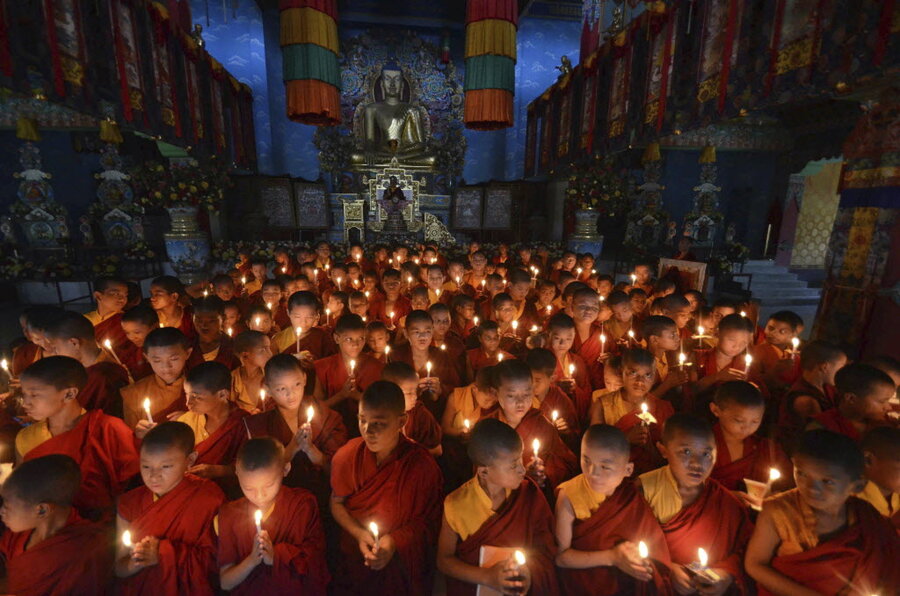Ancient Nepali shrine suggests new date for Buddha's birthday
Loading...
Archeologists have unearthed a Buddhist shrine in Nepal that puts Buddha’s birth in the sixth-century BC, at least a hundred years earlier than most scholars have in recent years plotted the date. The find, sure to be controversial, is the first material archeological evidence to support assigning Buddha’s life to a particular century.
The report will be published in the December issue of the journal Antiquity and broadcast as a National Geographic documentary this winter.
The timber shrine was found under newer, but also hidden, brick temples near the Maya Devi Temple in Lumbini, Nepal, at the toes of the Himalayas. The Maya Devi Temple, a UNESCO World Heritage site, has long been venerated as the location of the garden where Maya Devi, wife of King Suddhodana, gave birth to the future Buddha. The tale is recorded in a 249 BC pillar that the Mauryan Emperor Asoka put at the spot, commemorating the sacred birth that happened there and establishing the region as a point of pilgrimage for centuries to come.
In Buddhist tradition, Buddha was born as Siddhārtha Gautama, an heir to all the mansions, glittering baubles, and regal status of a dynastic Hindu lineage. But, at 29-years-old, the young prince spurned that wealth for a life less insulated from pain, more real. For years, he wandered the Earth with almost nothing at all. Then, he sat, under a Bodhi tree, and in mediation reached enlightenment.
Besides those plot points, scholars know little else about Buddha’s life. Even more vexingly, it has also been unclear just when any of those few plot points happened.
Some scholars have put Buddha’s life within the 3rd century BC, the same century that Emperor Asoka erected the pillar at Buddha’s birthplace and began unrolling the religion across Asia, from modern Afghanistan to Bangladesh. Still, that date for Buddha’s birth had not been supported with material archeological evidence, besides the pillar, and some scholars have argued that Buddha was born centuries before the religion began to spread.
How many centuries before, though, is a subject of debate, since no written records from Buddha’s lifetime have ever been found, and the texts from which scholars have teased out Buddha’s life – in large part, epic poems – were not written until hundreds and hundreds of years after his death. Splicing myth from fact has been difficult.
"Very little is known about the life of Buddha, except through textual sources and oral tradition," said archaeologist Professor Robin Coningham, of Durham University, U.K., who co-led the investigation, in a statement. “We thought 'why not go back to archaeology to try to answer some of the questions about his birth?'”
In the latest research, the team tested charcoal fragments from the lost shrine with radiocarbon dating, as well as sand grains using a similar technique known as optically stimulated luminescence. That testing put the shrine’s construction the sixth-century BC. Then, the team confirmed the presence of tree roots in the temple's central space, as well as the absence of telltale signs of ritual sacrifices in its interior. Together, those points suggest that the temple was a Buddhist one, not a Hindu one, and that Buddhism was already in existence and in practice at the time.
That Lumbini was already revered as a holy Buddhist site in the sixth-century BC is consistent with the date that some academic communities, including UNESCO World Heritage Centre, give for Buddha’s birth: 623 BC.
Still, some researchers not involved in the work have expressed caution that the found shrine could belong to an ancient, Indian religion, not to Buddhism, National Geographic reported. Even with more investigation, the find is unlikely to settle the question of when Buddha lived, the news magazine said.
Both the Japanese and Nepali government have contributed funding to the archeological team that recovered the buried shrine, in hopes of encouraging greater interest in and investment in Maya Devi Temple, an active temple.
"These discoveries are very important to better understand the birthplace of the Buddha," said Ram Kumar Shrestha, Nepal's minister of culture, tourism and civil aviation, in a statement. "The government of Nepal will spare no effort to preserve this significant site."








